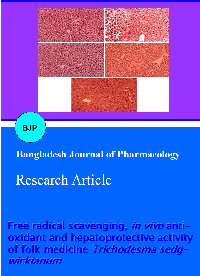Free radical scavenging, in vivo antioxidant and hepatoprotective activity of folk medicine Trichodesma sedgwickianum
DOI:
https://doi.org/10.3329/bjp.v8i1.13172Keywords:
ABTS, Antioxidant, Catechin, DPPH, Hepatoprotective, Lipid peroxidation, Trichodesma sedgwickianum, Superoxide radicalAbstract
Trichodesma sedgwickianum has been used in folk medicine possessing anti-inflammatory and hepatoprotective activity. This led us to investigate for its antioxidant and hepatoprotective potential. Different polarities extracts were subjected to polyphenolic estimation and in vitro antioxidant activity. The potential extract was tested for in vivo antioxidant and hepatoprotective activity, assessed by carbon tetrachloride-induced oxidative stress in rats. Phytochemical identification of major constituents has been carried out by HPLC, GC-MS, 1HNMR and 13C NMR. Amongst the extracts, successive ethanol extract showed higher concentration of polyphenols (25.4 ± 0.1% w/w) and in vitro antioxidant property. The in vivo antioxidant efficiency was confirmed by comparing the enzymatic level, superoxide dismutase, catalase, reduced glutathione and MDA in test group with the standard and control. Hepatoprotective effect was observed by changes in the serum enzyme level which were further supported by histological examination. Phytochemically ethanol extract contains gallic acid and catechin along with other constituents. Thus present study provides a scientific rationale for their traditional use.
Downloads
1845
836 Podcast
542 Read
379
References
Chan EWC, Lim YY, Omar M. Antioxidant and antibacterial activity of leaves of Etingera species (Zingiberaceae) in Peninsular Malaysia. Food Chem. 2007; 104: 1586-93.
Chung KT, Wong TY, Huang YW, Lin Y. Tannins and human health: A review. Crit Rev Food Sci. 1998; 36: 421-64.
Daonian Z, Jinlan R, Yaling C, Zhaomei X, Wei F, Anhua W. Antioxidant and hepatoprotective activity of ethanol extract of Arachniodes exilis (Hance) Ching. J Ethnopharmacol. 2010; 129: 232-37.
Espin JC, Garcia-Conesa MT, Tomas-Barberan FA. Nutraceuricals: Facts and fiction. Phytochem. 2007; 68: 2986-3008.
Halliwell B, Gutteridge JMC. Role of free radicals and catalytic metal irons in human disease: an overview. Method Enzymol. 1990; 186: 59-85.
Halliwell B. Free radicals, antioxidants and human diseases; curiosity, cause, or consequence? Lancet 1994; 334: 721-24.
Hubert J, Donfack R, Kengap T, Nagernani B, Pascal DD, Angela N, Tahala Paul F, Fulvio M. Ficus cordata Thunb (Moraceae) is a potential source of some hepatoprotective and antioxidant compounds. Pharmacologia 2011; 2: 137-45.
Hye MA, Taher MA, Ali MY, Ali MU, Zaman S. Isolation of (+)-catechin from Acacia catechu (Cutch Tree) by a convenient method. J Sci Res. 2009; 1: 300-05.
Kalaskar MG, Surana SJ. Free radical scavenging and hepatoprotective potential of Ficus microcarpa L. fil. bark extracts. J Nat Med. 2011; 65: 633-40.
Kaviarasan S, Naik GH, Gangabhagirathi R, Anuradha CV, Priyadarsini KI. In vitro studies on antiradical and antioxidant activities of fenugreek (Trigonella foenum graecum) seeds. Food Chem. 2007; 103: 3137.
Kirtikar KR, Basu BD. Indian Medicinal plants. 2nd ed. India, International Book Distributors, 1935.
Kuhnle G, Spencer JPE, Schroeter H, Shenoy B, Debnam ES, Srai SK, Rice-Evans C, Hahn U. Epicatechin and catechin are o-methylated and glucuronidated in the small intestine. Biochem Bioph Res Co. 2000; 277: 507-12.
Kumaraswamy MV, Raghavendra MP, Satish S. Antioxidant and anti-inflammatory activity of Woodfordia fructicosa Kurz. J Pharm Res. 2010; 3: 1492-95.
Li R, Chen WC, Wang WP, Tian WY, Zhang XG. Antioxidant activity of Astragalus polysaccharides and antitumour activity of the polysaccharides and siRNA. Carbohr Polym. 2010; 82: 220-44.
Liu CZ, Yu JC, Zhang XZ, Wang T, Han JX. On changes of activity of antioxidases in hippocampus of rats with multi-infarct dementia and the intervention effects of acupuncture. China J Trad Chinese Med Pharm. 2005; 20: 724-26.
Ploa GL, Hewitt WR. Detection and evaluation of chemically induced liver injury. In: Principle and Methods of Toxicology. Wallace HA (ed). 2nd ed. New York, Raven Press, 1989, pp 399-628.
Recknagel RO. A new direction in the study of carbon tetrachloride hepatotoxicity. Life Sci. 1983; 33: 401-08.
Shahidi F. Natural antioxidants: chemistry, health effects and applications. 4th ed. USA, AOCS Press, 1997, pp 366-69.
Srinivasan R, Chandrasekar MJN, Nanjan MJ, Suresh B. Anti-oxidant activity of Caesalpinia digyna root. J Ethnopharmacol. 2007; 113: 284-91.
Tanigawa S, Fujii M, Hou DX. Action of Nrf2 andKeap1 in ARE mediated NQO1 expression by quercetin. Free Radic Biol Med. 2007; 42: 1690-703.
Wei F, Jinglou C, Yaling C, Yongfang LA, Liming C, Lei P, Daonian Z, Xiaofei L, Jinlan R. Antioxidant, free radical scavenging, anti-inflammatory and hepatoprotective poten-tial of the extract from Parathelypteris nipponica (Franch. et Sav.) Ching. J Ethanopharmacol. 2010; 130: 521-28.

Published
How to Cite
Issue
Section
License
Authors who publish with this journal agree to the following terms:
- Authors retain copyright and grant the journal right of first publication with the work simultaneously licensed under a Creative Commons Attribution License that allows others to share the work with an acknowledgement of the work's authorship and initial publication in this journal.
- Authors are able to enter into separate, additional contractual arrangements for the non-exclusive distribution of the journal's published version of the work (e.g., post it to an institutional repository or publish it in a book), with an acknowledgement of its initial publication in this journal.
- Authors are permitted and encouraged to post their work online (e.g., in institutional repositories or on their website) prior to and during the submission process, as it can lead to productive exchanges, as well as earlier and greater citation of published work (See The Effect of Open Access).
